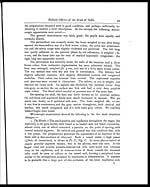Medicine - Institutions > Army health reports and medical documents > Scientific memoirs by medical officers of the Army of India > Part X, 1897 > 2 - Notes on the malarial parasite as observed in the blood during life, and in the tissues post-mortem, at Lahore, Punjab
(56) Page 50
Download files
Individual page:
Thumbnail gallery: Grid view | List view

50
Scientific Memoirs by
parasite-laden cells may be due to the parasites causing the affected hæmocytes
to become of lower specific gravity than the blood plasma, and thus to render
their circulation through narrow capillaries more difficult. They would thus get
filtered out of the blood and remain behind, while the healthy cells would be able
to pass on.
2. The Lungs. —The capillaries of the alveolar walls were in a very similar
condition to those of the brain, being full of pigmented, parasite-bearing, red
cells, while the veins contained large phagocytic cells laden with coarse mela-
notic pigment.
3. The Liver. —Here the appearances met with were different. The hepa-
tic cells were in a state of cloudy swelling, with granular protoplasm and indis-
tinct nuclei; the capillaries were distended at some parts, apparently contract-
ed at others, and all contained large numbers of macrophages and phagocytic
leucocytes deeply laden with thick, coarse pigment. The endothelial lining of
the capillaries was also deeply pigmented. No dark pigment existed in the
liver cells themselves, but most contained the golden brown pigment first de-
scribed by Kelsch and Kiener, in great abundance. This takes on a black
colour when treated with sulphide of ammonium and is apparently derived from
broken up red blood corpuscles and perhaps from hæmoglobin dissolved in the
blood plasma, which is excreted by the liver cells. The connective tissue stroma
throughout the organ showed marked proliferation of its cellular elements,
particularly in the neighbourhood of the branches of the portal veins.
4. The Spleen. —The capsule was thickened and the fibrous trabeculæ in-
creased in size, probably from old malarial infection. On the under surface
of the capsule and the margins of the sections of trabeculæ, proliferation of the
fibrous tissue cell-elements was marked. The pulp was full of parasites in all
stages of development (Pl. II., fig. D. ), the spore-producing and young amœ-
boid forms being much commonest. In addition, the whole section was black
with large splenic cells (fig. D. 7 ), and smaller leucocytes (fig. D. 6 ), laden with
coarse accumulations of dark sepia pigment. A few nucleated red blood cells
were also seen (fig. D. 5 ). The Malpighian bodies, and lymphocytes generally
wherever they occur, were found to contain no pigment.
5. The Kidneys —Contained fewer parasite-laden cells, but some, to-
gether with melaniferous phagocytes, were found in the intertubular capil-
laries, and those of the Malpighian tufts. The tubular epithelium throughout
was in a state of cloudy swelling. The capsule was thickened, and small areas
of excessive proliferation of interstitial fibrous tissue existed here and there in ir-
regular patches.
6. The Intestine. —The capillaries were again found to be full of parasite
laden red cells, though much less so than those of the brain. No hæmorrhage
had taken place and the condition of the mucous membrane was healthy. In
Set display mode to: Large image | Zoom image | Transcription
Images and transcriptions on this page, including medium image downloads, may be used under the Creative Commons Attribution 4.0 International Licence unless otherwise stated. ![]()
| Permanent URL | https://digital.nls.uk/75003210 |
|---|
| Shelfmark | IP/QB.10 |
|---|---|
| Additional NLS resources: | |




